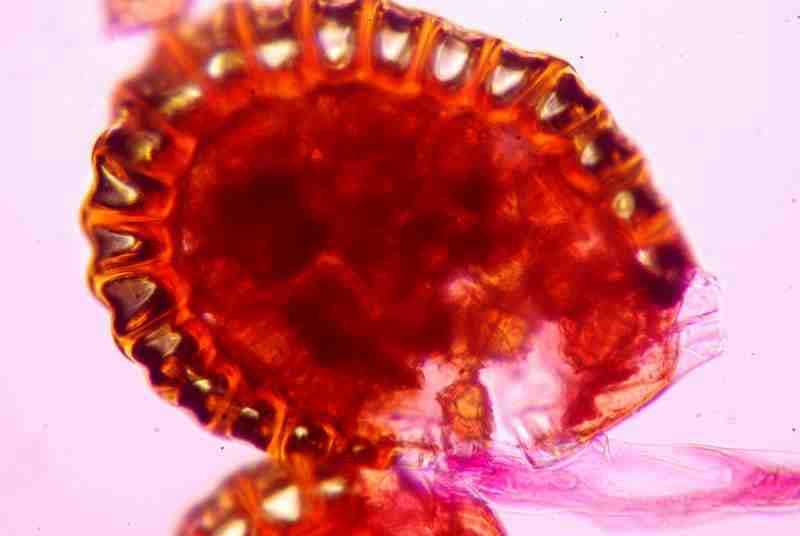Excerpts from Jim Conrad's
Naturalist Newsletter

from the December 19, 2010 Newsletter issued from Hacienda Chichen Resort beside Chichén Itzá Ruins, central Yucatán, MÉXICO; limestone bedrock, elevation ~39m (~128ft), ~N18.52°, ~W95.15°
FERN SPORANGIUM ANNULUSES
Last week we looked at the Triangle Spleenwort fern growing on the stone wall outside the Hacienda's public bathroom. One picture showed the elongate fruit dots, or sori, on the frond's undersurface, still seen at www.backyardnature.net/n/10/101212fp.jpg.
Last week I explained that the brown, granular material comprising the sori wasn't a mass of spores, but rather masses of "baglike sporangia, which when mature snap open and release spores. Each sporangium contains 64 spores."
Newsletter reader Dale Denham-Logsdon in Toluca, in the central Mexican highlands, just happened to be making microphotographs of Asplenium sporangia when the Newsletter arrived, and he's offered to show us what a fern sporangium looks like under high magnification. Dale's red-stained sporangium is at the top of this page.
That sporangium, from Asplenium nidus of Asia, is especially interesting because it so clearly shows the annulus, which is the segmented structure curling around 3/4s of the sporangium's perimeter, like the bushy crest of a knight's helmet. You can vaguely make out spherical spores inside the sporangium.
When sporangia are mature and exposed to dry air they begin drying out. As their annulus cells lose moisture they contract, placing tension on the sporangium's walls below them. Eventually the tension ruptures the walls and pulls the sporangium's top back, enabling some spores to escape. At this point the cracked-open sporangium looks like a knight laughing hugely, with spores tumbling from his mouth.
The annulus's cell walls are so thick that once the cells have shriveled to a certain size they don't collapse any further. Instead, the remaining fluid inside the annulus cells finds itself under a negative pressure. As drying continues eventually a threshold is crossed at which a cell's fluid under negative pressure suddenly is replaced by a gas bubble that fills the cell and allows the cell to very quickly expand to its natural size. This fast-occurring event disturbs neighboring cells, setting off a chain reaction of similar events, so that all the annulus cells working together "snap" the top part of the sporangium head forward, in the process flinging spores in all directions.
So, the annulus cells help with the fern's spore dissemination.